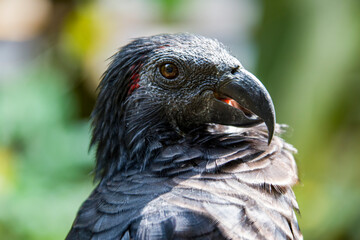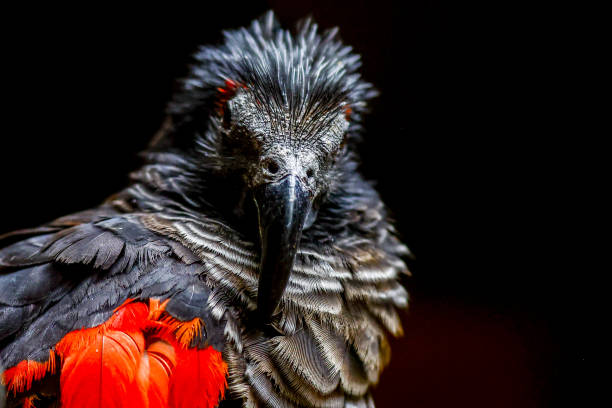Table of Contents
Scientific Classification
| Kingdom | Animalia |
| Phylum | Chordata |
| Class | Aves |
| Order | Psittaciformes |
| Family | Psittaculidae |
| Genus | Psittrichas |
| Species | Psittrichas fulgidus |
| Scientific Name | Psittrichas fulgidus |
1. Description
The Dracula Parrot, also known as Pesquet’s Parrot, is a truly remarkable bird that calls the rainforests of New Guinea home. It can grow up to 46 cm (18 inches) in length and typically weighs between 600 and 800 grams (1.3 to 1.8 lbs). Its body is a striking jet black, while its belly, wings, and tail are adorned with vibrant scarlet feathers. One of its most eye-catching features is its bare, black facial skin, which gives it a somewhat vulture-like appearance, earning it the nickname “Vulturine Parrot.” This unusual look actually serves a purpose, as it helps the bird adapt to its fruit-based diet by preventing sticky fruit pulp from clinging to its feathers.
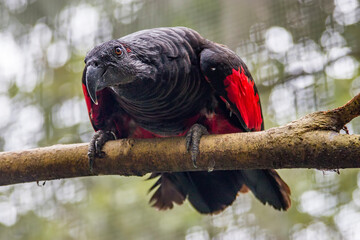
2. Distribution
This bird can be found in both Papua New Guinea and the Indonesian province of Papua. Its habitat is closely tied to the availability of its favorite food, which leads to seasonal migrations.
3. Habitat
The Dracula Parrot thrives in the lush hill and montane rainforests, typically hanging out at elevations between 600 and 1,200 meters (or 2,000 to 4,000 feet). These rich, humid forests are a paradise for this bird, offering plenty of food and cozy nesting spots. You’ll often find it in areas filled with fig trees, which play a vital role in its diet.
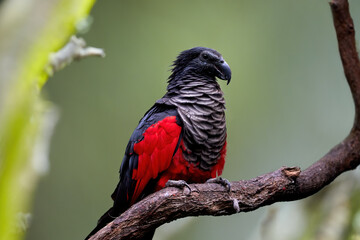
4. Diet
When it comes to food, the Dracula Parrot is a frugivore, which means it primarily munches on specific types of figs. Its strong, curved beak is just right for getting to the tasty pulp inside these fruits. Every now and then, it might also snack on flowers and sip some nectar. Interestingly, the bird’s bare face probably helps prevent its feathers from getting all matted up with those sticky fruit juices.
5. Behavior
The Dracula Parrot is often spotted in pairs or small flocks of up to 20. It’s well-known for its loud, rasping calls that resonate throughout the forest. These vocalizations not only help keep the group together but may also act as signals to mark their territory. When flying, this bird has a unique rhythm: it flaps its wings rapidly before gliding for a while. This technique is a clever way to conserve energy during long flights.
6. Lifespan
When it comes to the Dracula Parrot, we don’t have a lot of information about their lifespan in the wild. However, in captivity, these fascinating birds can live for as long as 40 years if they receive the right care and nutrition.
7. Reproduction and Lifecycle
When it comes to the breeding habits of the Dracula Parrot in the wild, there’s still a lot we don’t know. It’s thought that they make their nests in big, hollow trees, where they typically lay one or two eggs each breeding season. Unfortunately, we don’t have much information on how long the incubation lasts or how the fledglings develop. However, similar to many other parrots, it’s likely that both parents pitch in to care for their young.
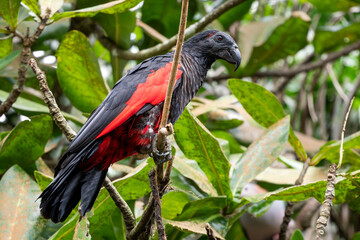
8. Nest
Dracula Parrots are known for being cavity nesters, and they really love to find large, hollow trees to lay their eggs in. These cozy nests offer them a safe haven from predators and harsh weather. Unfortunately, the ongoing deforestation is making it harder for them to find suitable nesting spots, which poses a significant threat to their ability to reproduce.
9. Mating Season
While the exact timing of breeding isn’t well-documented, it probably occurs when there’s an abundance of fruit. This ensures that there’s plenty of food available for the chicks as they grow. Typically, this coincides with the rainy season in New Guinea, which is when fig trees are at their most fruitful.
10. Breeding
After mating, the female lays one or two eggs in her chosen nest cavity. While she incubates the eggs, the male takes on the role of provider, bringing food to her. Once the eggs hatch, both parents are involved in feeding the chicks until they’re ready to fledge. However, the exact duration of the incubation and fledging periods remains a bit of a mystery, mainly because there haven’t been many field studies conducted on this.
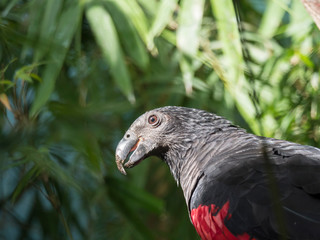
11. Predators
When it comes to the Dracula Parrot, its natural enemies include birds of prey like hawks and eagles. The little ones, including nestlings and eggs, are also at risk from snakes and tree-dwelling mammals. However, the most significant danger to these stunning birds comes from humans. Sadly, they are hunted for their gorgeous feathers and captured for the illegal pet trade.
12. Adaptations
- Bare Facial Skin: Prevents feather matting from sticky fruit juices.
- Strong, Hooked Beak: Ideal for extracting fig pulp.
- Loud Calls: Facilitate communication in dense forests.
- Flight Pattern: Alternating flapping and gliding conserves energy.
13. Conservation Status
The Dracula Parrot is currently classified as “Vulnerable” on the IUCN Red List. This status stems from threats like habitat destruction and hunting. Its stunning feathers are in high demand, making it a target for the illegal pet trade. To combat these issues, conservation efforts are focused on protecting its natural habitat and enforcing stricter laws against hunting and trafficking.
14. Interesting Facts
Unique Appearance: This parrot’s vulture-like look is quite a rarity in the parrot world.
Specialized Diet: It primarily munches on figs, making its diet quite specific.
Limited Range: You can only find it in the lush rainforests of New Guinea.
Longevity: These birds can live for an impressive 40 years!
Conservation Symbol: It plays a vital role as a flagship species for rainforest conservation efforts in New Guinea.
The Dracula Parrot showcases the incredible diversity and specialization found in nature. Its striking features and captivating appearance make it truly fascinating. Plus, it stands as a symbol of the conservation initiatives in its native habitat.
